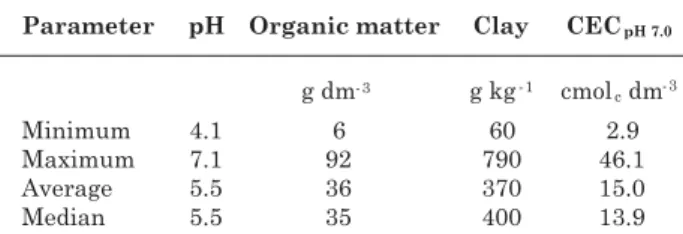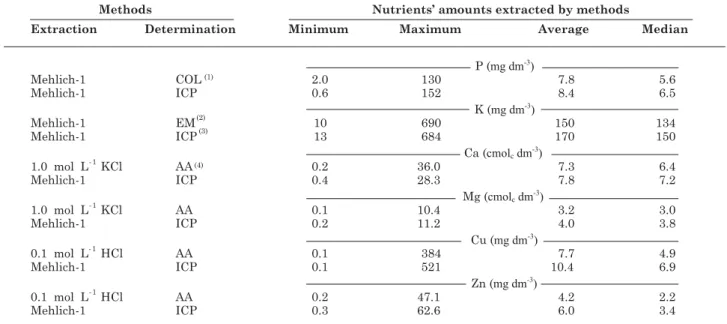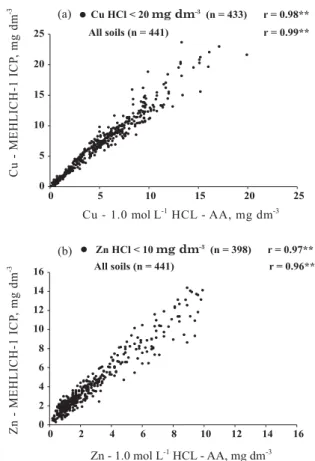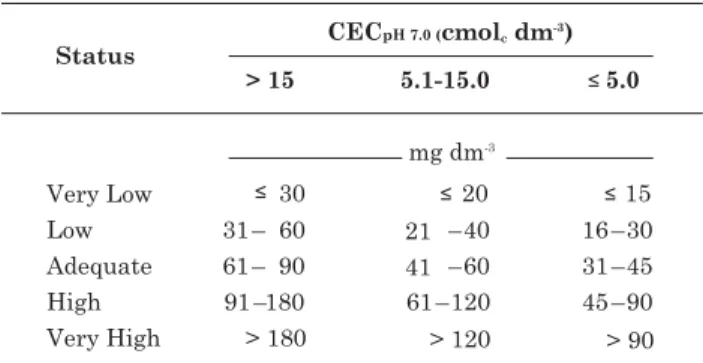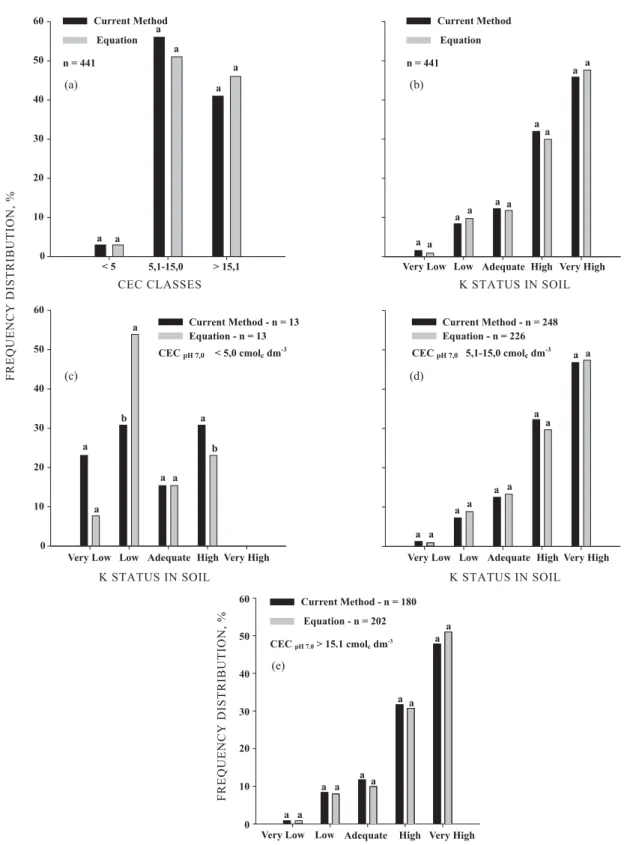SIMULTANEOUS MULTIELEMENT EXTRACTION WITH THE
MEHLICH-1 SOLUTION FOR SOUTHERN BRAZILIAN SOILS
DETERMINED BY ICP-OES AND THE EFFECTS ON THE
NUTRIENTS RECOMMENDATIONS TO CROPS
(1)Leandro Bortolon(2) & Clesio Gianello(3)
SUMMARY
The amounts of macro (P, K, Ca and Mg) and micronutrients (Cu and Zn) extracted with the Mehlich-1 (M1) solution, by the 1.0 mol L-1 KCl (KCl) and with
the 0.1 mol L-1 HCl (HCl) for representative soil types of the Rio Grande do Sul
state (Brazil) were compared with those extracted with the Mehlich-1 solution determined with the inductively coupled plasma optical emission spectroscopy (ICP). The amounts of nutrients extracted by the different methods showed high correlation coefficients. On average, the Mehlich-1 solution extracted similar amounts of P, determined with colorimetric and ICP methods, and, K determined with emission and ICP. The amounts of Ca and Mg extracted with the Mehlich-1 solution, determined by ICP, were similar to those extracted with the KCl solution determined by the atomic absorption spectrophotometry. The amounts of Cu and Zn extracted with the Mehlich-1 solution, determined by the ICP, were higher than those extracted with the 0.1 mol L-1 HCl determined by the atomic absorption
spectrophotometry. The results indicate that the Mehlich-1 solution and ICP can be used for simultaneous multielement extraction and determination for Southern Brazilian soils. However, a conversion factor for values interpretation is needed. The use of the conversion factor to determine the K availability index in soils is adequate and does not affect the K recommendations for crops in southern Brazilian soils.
Index terms: soil testing, ICP, Mehlich-1.
(1) Research supported by Soil testing Laboratory of Soils Department of Universidade Federal do Rio Grande do Sul – UFRGS and CNPq. Received for publication in April 2009 and aproved in October 2009.
(2) Post-Doctoral Research Associate of Soils Department, Universidade Federal do Rio Grande do Sul – UFRGS. Av Bento Gonçalves 7712, CEP 81540-000 Porto Alegre (RS). E-mail: leandro.bortolon@ufrgs.br
RESUMO: EXTRAÇÃO MULTIELEMENTAR SIMULTÂNEA COM A SOLUÇÃO DE MEHLICH-1 PARA SOLOS DO SUL DO BRASIL E DETERMINAÇÃO POR ESPECTROFOTOMETRIA DE EMISSÃO ÓTICA POR PLASMA INDUZIDO E OS EFEITOS NAS RECOMENDAÇÕES DE ADUBAÇÃO PARA AS CULTURAS
As quantidades de macro (P, K, Ca e Mg) e micronutrientes (Cu e Zn) extraídos com a solução de Mehlich-1 (M1), por KCl 1,0 mol L-1 (KCl) e com o HCl 0,1 mol L-1 (HCl), em solos
representativos do Rio Grande do Sul, foram comparadas com as quantidades de nutrientes extraídos com a solução de Mehlich-1 determinados por espectrofotometria de emissão ótica por plasma induzido (ICP-OES). Os teores de nutrientes extraídos pelos diferentes métodos tiveram alto grau de correlação. Em média, a solução de Mehlich-1 extraiu quantidades semelhantes de P determinado por colorimetria e por ICP, bem como de K determinado por emissão e ICP. Os teores de Ca e Mg extraídos com a solução de Mehlich-1, determinados por ICP, foram semelhantes aos dos extraídos com a solução de KCl determinada por espectrofotometria de absorção atômica. Os teores de Cu e Zn extraídos com a solução de Mehlich-1, determinados por ICP, foram maiores do que os extraídos com a solução de HCl determinada por espectrofotometria de absorção atômica. Os resultados indicam que a solução de Mehlich-1 e o ICP podem ser usados para extração e determinação multielementar simultânea de solos do sul do Brasil, porém o uso de um fator de conversão para interpretação de valores é necessário em alguns casos. O uso do fator de conversão para determinar o índice de disponibilidade de K no solo é adequado e não altera as recomendações de K para as culturas.
Termos de indexação: análise de solo, ICP, Mehlich-1.
INTRODUCTION
Soil multielement extracting solutions are used by several soil testing laboratories to determine some nutrients availability for crops in order to decrease costs and labor. The first solution widely used was proposed by Mehlich (1953) by extracting the available P, K, Ca, Mg and Zn in noncalcareous soils
(Mehlich-1 – M1). The advantages of the multielement
extracting solutions became more clear with the development of the inductively coupled plasma emission spectrometer (ICP-OES) which can determine several elements on the same extract with high analytical precision, low detection limit, and an extended dynamic range (Raij, 1994).
The M1 solution is used by several laboratories to
determine available P and K in acidic soils from Brazil.
For southern Brazilian soils, the M1 solution is used
to evaluate P and K availability, with a 1.0 mol L-1
KCl solution to evaluate exchangeable Na, Mn, Al,
Ca and Mg and 0.1 mol L-1 HCl for available Cu and
Zn (Tedesco et al., 1995). However, the Mehlich-1 solution was calibrated for simultaneous multielement extraction of P, K, Ca, Mg, Cu and Zn for southern Brazilian soils, and the nutrients determination was done by colorimetric (P), atomic absorption (Ca, Mg, Cu and Zn) and flame emission (K) methods (Bortolon & Gianello, 2008).
The use of ICP in soil testing laboratories has expanded rapidly since the early 1990’s (Munter, 1990;
Raij, 1994). The ICP is based on the characteristic optical emission of atoms excited in high-temperature (5.000–8.000 K) argon plasma and provides simultaneous analysis of many elements. Because samples’ molecules injected into the plasma undergo instantaneous vaporization, dissociation, and are excited, ICP can measure other nutrients’ forms than those determined by other determination techniques (colorimetric, atomic absorption, flame emission) (Nathan et al., 2002). In southeast Brazilian soils, differences were identified in the Cu and Zn amounts extracted by the Mehlich-1 solution as determined by the ICP and atomic absorption (Milagres et al., 2007). For Southern Brazilian soils, Bortolon & Gianello (2008) did not observe differences of the P amounts extracted by the Mehlich-1 solution, determined by the colorimetric and ICP methods. The differences were found between the P amounts extracted by the Mehlich-3 solution, determined by colorimetric and ICP methods, because ICP can measure other P forms in addition to orthophosphate. Thus, the P measured with ICP is up to 50 % higher than P measured with colorimetric method, and research has suggested that the additional P is mainly organic P (Hylander et al., 1995; Eckert & Watson, 1996; Nathan et al., 2002).
ICP soil testing efficiency being necessary to increase the information regarding ICP efficiency in a wide range of soils from Brazil (Milagres et al., 2007; Bortolon & Gianello, 2008; Bortolon et al., 2007a,b).
The objective of this work was to investigate the macro (P, K, Ca and Mg) and micronutrient (Cu and Zn) amounts extracted with the current soil testing methods used in southern Brazilian soil testing laboratories, and compare that to those extracted with the Mehlich-1 solution as determined by the ICP technique. In addition, we evaluated the effect of the ICP use for K recommendations for crops.
METHODOLOGY
This study was conducted with 441 soil samples sent by farmers for soil fertility evaluation with widely distributed soil types (Haplorthox, Hapludult, Argiudoll, Argiaquoll, Paleudalf, Paleudert, Haplumbrept, Haplohumult, Haplohumox) with a wide range of chemical, physical, and mineralogical properties (Table 1).
The amounts of P, K, Ca, Mg, Cu and Zn were
extracted with Mehlich-1 (M1) (0.05 mol L-1 HCl +
0.0125 mol L-1 H
2SO4; pH 1,2) in a soil:solution ratio
of 1:10, and shaken for 5 min on a reciprocating shaker
at 120 oscillations min-1 and standing overnight (16 h).
After 16 h, the nutrients in the extracts were determined by ICP (Gartley et al., 2002). An aliquot of the extract was used for P colorimetric (COL) determination (1-amino-2-naftol-4-sulfonic and ammonium molibdate method), and another aliquot was used for K by flame photometry (EM). Ca and
Mg were also extracted with 1.0 mol L-1 KCl in a
soil:solution ratio 1:2 and Cu and Zn by 0.1 mol L-1
HCl in a soil:solution ratio 1:4. Both were shaken for 30 min on a reciprocating shaker at 120 oscillations
min-1 and standing overnight (16 h). The Ca, Mg, Cu
and Zn were determined in the extract by atomic absorption spectrometry (AA). The extract filtration procedure was replaced by standing overnight. All samples were extracted in triplicate in three different days totaling nine replicates of each sample.
The data were compared by correlation between the amounts extracted by the different methods and the mathematical equations which were adjusted by the linear model. The K data interpretation between cation exchange capacity (CEC) calculated by current method and CEC calculated with ICP equation were compared using paired-t test (p < 0.05).
RESULTS AND DISCUSSION
Soil pH of the 441 soils ranged from 4.1–7.1, indicating the wide pH range of the predominant soils in southern Brazil. The soil clay ranged from 100 to
790 g kg-1, with a mean of 370 g kg-1 which is common
in agricultural soils of Rio Grande do Sul state used for crop production. Mean organic matter content
(Walkley–Black) of the soils was 36 g kg-1, and ranged
from 6 to 92 g kg-1, which is common organic matter
content found in southern agricultural soils of Brazil. These data reflected the variable and wide range of physical, chemical, and mineralogical characteristics of soils in southern Brazil.
Extractable soil P values obtained by the M1
solution were in the range generally determined for agricultural soils (Table 2). However, there are some values extremely elevated above values found in agricultural soils. On average, the amounts of P
extracted with the M1 solution determined by COL
and ICP were similar (Table 2), and high correlation coefficient between them for all soils used in this work (Figure 1a). Because of the wide range of extractable soil P, the data were compared excluding the soils with extractable P by Mehlich-1 solution higher than
40 mg dm-3. This reference value indicates the P
status in soil classified “very high” for southern Brazilian soils and the P recommendations is based on plant requirements (SBCS/NRS, 2004). The correlation between the P amounts extracted by the
M1 solution, determined by the COL and by the ICP
methods, had a high degree association (0.91**; Figure 1a). These data are according to Bortolon & Gianello (2008) using 551 soil samples from southern Brazil. The colorimetric interpretation table can be used for the ICP values index without affecting the P recommendations for crops (Bortolon & Gianello, 2008). The high association degree between the P amounts determined by the COL and ICP methods indicates the methods determine the same pool of P in the extract.
The extractable soil K is shown on Table 2. On average, the range of K amounts extracted with the
M1 solution is common in agricultural soils of the Rio
Grande do Sul state (Table 2). The K amounts
extracted with the M1 solution determined by EM and
ICP were similar (Table 2). The correlation between the K amounts extracted by the M1 solution determined by the EM and ICP methods had a high degree of association (r = 0.99**; Figure 1b). The
Table 1. Characterization of the pH values, the clay and organic matter (OM) of the soils used in this work(1)
amplitude of the K values was very high, for this reason, the data was reprocessed using soils with K
amounts extracted by the M1 solution lower than
200 mg dm-3. This reference value indicates the K
status in soil classified “very high” for southern Brazilian soils and the K recommendations is based on plant requirements (SBCS/NRS, 2004). For these
soils, the correlation between the extractable M1 K
determined by the methods had a high coefficient value (r = 0.98**; Figure 1b), indicating that the same K pool in solutions are accessed by the determination methods. The EM and ICP have the same chemical determination process; however, the efficiency of the plasma on the atoms’ excitation is higher than the flame because the temperature of plasma is very high (5000-8000 K). Thereby, the 13 % of K amounts determined by the ICP was found, but without statistical difference by the “t” test. The results indicate that ICP can be used for K determination in
M1 soil extracts in southern Brazil, replacing the EM
method, reducing costs and labor, and, consequently increasing the laboratory efficiency.
The Ca amounts extracted by the KCl solution determined by the AA was similar to those extracted
by the M1 solution determined by the ICP (Table 2)
and with a high degree of association between them (Figure 2a) when considering all soils. The replacement of soils with Ca amounts extracted by
the KCl above 20 cmolc dm-3 did not affect the
correlation. The Mg amounts extracted by the M1
solution determined by the ICP were, on average, 25 % higher than those extracted by the KCl solution; however, no statistical differences were found (Table 2).
Figure 1. Correlation between the phosphorus amounts extracted by the Mehlich-1 solution determined by the colorimetric (COL) and ICP methods (a) and the K amounts extracted by the Mehlich-1 solution determined by the flame emission (EM) and ICP methods (b).
Table 2. Nutrient amounts extracted by soil test methods on soils used in this work
The correlation had a very high degree of association between the Mg amounts extracted by these methods (Figure 2b). The data showed that the extraction methods access the same pool of Ca and Mg in soils and the determination methods access the same pool of Ca and Mg from the extract solution. Comparable correlation coefficients and regression relationships have been reported elsewhere in the literature (Gascho et al., 1990; Evans & McGuire, 1990; Alva, 1993; Gartley et al., 2002). For southern Brazilian soils, a few studies were conducted to compare the Ca and Mg
amounts extracted by the M1 solution, however, the
studies reported the M1 efficiency to evaluate Ca and
Mg in soils (Miola, 1995; Kroth, 1998; Bortolon, 2005).
The Cu and Zn amounts extracted by the M1
solution determined by ICP were, on average, 40 % higher than those extracted by the HCl solution determined by AA (Table 2). The relationship between the Cu and Zn amounts extracted by the solutions and determined by the methods had a high degree of association (Figure 3a,b) when using all soils or using soil with Cu amounts extracted by the HCl solution
above 20 mg dm-3 and Zn amounts, extracted by the
HCl solution above, 10 mg dm-3. Similar results were
found by Milagres et al. (2007) using soils from southeast Brazil. Obtained Cu and Zn amounts extracted by the Mehlich-1 solution determined by ICP were, on average, 35 % more than the Cu and Zn amounts determined by the AA. Probably the higher amounts determined by ICP are related to the high Cu and Zn complexed in the solution by organic molecules. The flame of the atomic absorption does not have enough energy to release the Cu and Zn from the solution, and they did not quantify. The opposite occurs in the ICP method, because the plasma energy is higher than the flame and can release Cu and Zn complexed in the solution by organic molecules and can be evaluated. Based on these results, a simple substitution is possible if a conversion factor is used for these elements.
In comparing micronutrient soil tests, it is important to remember that in many cases, the interpretation of these tests is not based solely on the concentration of the nutrients measured by the soil tests, but on their relationship with other soil properties, such as soil pH and organic matter in the form of an availability index. While inclusion of these properties in the analysis did not improve the
Figure 2. Correlation between the calcium (a) and magnesium (b) amounts extracted by the 1.0 mol L-1 KCl solution determined by the
atomic absorption spectrometry (AA) and the calcium and magnesium amounts extracted by the Mehlich-1 solution determined by the ICP method (a).
predictive aspect of these relationships for estimating soil concentration, they have been shown to improve the interpretation of the concentration with respect to plant availability in specific soils. In using regression equations to convert between “equivalent soil test” values of different extractants, it is important to consider whether the use of the “predicted values” rather than “actual” values will impact the accuracy of the availability indices, since the extractants involved may actually be measuring different pools of the micronutrients in the soil (Gartley et al., 2002).
The regression equations developed in this study as conversion equations between different soil test extractants and determination methods are shown on table 3. However, even simple linear relationships with the included slope and intercept values can be cumbersome for day-to-day use. From the standpoint of practicality and ease of use, a simple “conversion factor” by which a soil test result could be multiplied is more desirable. Such a format would be easier to use as well as less prone to transcription error by the individual trying to remember specifics of a given equation such as whether an intercept is positive or negative. In some cases, “no-intercept” regression models are acceptable. Whether this expectation could be applied to the relationship between different soil
Table 3. Equations, R2 values and 95 % confidence intervals for all nutrient–extractant relationships
developed using intercept regression models
(1) COL: Colorimetric method; EM: flame emission spectrometry; ICP: inductively coupled plasma optical emission spectrometry; AA: atomic absorption spectrometry; M1: Mehlich-1; KCl: 1.0 mol L-1 KCl; HCl: 0.1 mol L-1 HCl.. (2) P, K, Cu and Zn – mg dm-3 and Ca and Mg – cmolc dm-3.
test extractants is less certain as soil test extractants measure “extractable” rather than “total” concentrations. Since soil test extractants may be measuring different “pools” of nutrients in the soil and also vary in extraction efficiency due to differences in their chemical composition, it is possible that one soil test extractant may yield a result of “0” while a second does not for the same soil sample, simply because of differences in extraction chemistry (Gartley et al., 2002).
The CEC is used for interpretation of K status for southern Brazil soils and fertilizer recommendations and they are classified according to table 4. The CEC
is separated in three classes: > 5.0 cmolc dm-3; 5.1–
15.0 cmolc dm-3; and > 15.1 cmolc dm-3. The K status
in each class is classified in Very Low (VL), Low (L), Adequate (A), High (H), and Very High (VH). Each class has a specific critical level value for adequate K status in soils. The use of the conversion equation to calculate the CEC in soils may affect the K recommendations for the plants in soils for southern Brazil. Thereby, it was demonstrated that the use of a conversion factor to calculate CEC and to classify the K status in soils can be used in these soils (Figure 4). Figure 4 shows the CEC distribution of the soils used in this work. Most of the samples are
Table 4. Potassium status in soil from Southern Brazil1 according to CEC
pH 7.0
(1) SBCS/NRS (2004).
classified on CEC higher than 5.1 cmolc dm-3, since
that is the common CEC found in agricultural soils for southern Brazil. In almost 80 % of the soils, the K status is classified “High” or “Very High”. In this case, the K amount, amended by fertilizer, is listed according to the plant requirements (maintenance). The differences between the K status in soils, estimated by the current soil test methods and by the use of a conversion factor, did not show statistical differences in each of the CEC classes. For this reason, the conversion factor for estimating K status in soils when using ICP is possible in soils for southern Brazil.
However, in soils with CEC lower than 5.0 cmolc dm-3,
Low” and “Low”. The use of the conversion factor underestimated the K amounts in soils classified with
“Very Low” and overestimated the K amounts in soils classified by “Low”. On the other hand, the soils with
Figure 4. Frequency histogram of the samples used in this work; (a) CEC classes; (b) K status in soil including all CEC classes; (c) K status in soil CEC < 5.0 cmolc dm-3; (d) K status in soil CEC 5.1-15.0 cmol
c dm-3; (e)
K status in soil CEC > 15.1 cmolc dm-3. Freequencies followed by the same letters in each class do not
lower CEC represent less than 3 % of the soils used in this work, representing soils with high sandy content, commonly used in Southern Brazil for tobacco and vegetable production. In these production systems, the K recommendations are based on the plant requirements and K status in soils is not considered in the K recommendation scheme.
CONCLUSIONS
The results indicate that the simultaneous multielement extraction and determination of available P, K, Ca, Mg, Cu and Zn in soil can be evaluated with Mehlich-1 solution and inductively coupled plasma optical emission spectroscopy in southern Brazilian soils. However, it is necessary to use a conversion factor for the availability index. The use of the conversion factor to determine K availability index in soils is adequate and does not affect the K recommendations for the plants. The use of Mehlich-1 combined with ICP increase the soil testing laboratory efficiency and decreases cost and labor being a viable alternative to be used by laboratories.
LITERATURE CITED
ALVA, A.K. Comparisons of Mehlich 3, Mehlich 1, ammonium bicarbonate-DTPA, 1.0 M ammonium acetate, and 0.2 M ammonium chloride for extraction of Ca, Mg, P, and K for a wide range soils. Comm. Soil Sci. Plant Anal., 24:603-612, 1993.
BORTOLON, L. Métodos de avaliação da disponibilidade de nutrientes para as plantas em solos do Rio Grande do Sul. Porto Alegre, Universidade Federal do Rio Grande do Sul, 2005.111p. (Tese de Mestrado)
BORTOLON, L. & GIANELLO, C. Interpretação de resultados analíticos de fósforo pelos extratores 1 e Mehlich-3 em solos do Rio Grande do Sul. R. Bras. Ci. Solo, Mehlich- 32:2751-2756, 2008.
BORTOLON, L.; GIANELLO, C. & KROTH, P.L. Extração simultânea de P, K, Ca, Mg, Cu e Zn pela solução de Mehlich-1 determinados por ICP. In: CONGRESSO BRASILEIRO DE CIÊNCIA DO SOLO, 31., Gramado, 2007. Anais. Viçosa, MG, Sociedade Brasileira de Ciência do Solo, 2007a. CD ROM.
BORTOLON, L.; GIANELLO, C. & KROTH, P.L. Fósforo extraído do solo pela solução de Mehlich-1 determinado por colorimetria e por ICP. In: CONGRESSO BRASILEIRO DE CIÊNCIA DO SOLO, 31., Gramado, 2007. Anais.Viçosa, MG, Sociedade Brasileira de Ciência do Solo, 2007b. CD ROM.
ECKERT, D.J. & WATSON, M.E. Integrating the Mehlich-3 extractant into existing soil test interpretation schemes. In: HOOD, T.M. & JONES, J.B. Soil and plant analysis in sustainable agriculture and environment. New York, Marcel Dekker, 1996.
EVANS, C.E. & McGUIRE, J.A. Comparison of soil test extractants on Alabama soils. Comm. Soil Sci. Plant Anal., 21:1037-1050, 1990.
GARTLEY, K.L.; SIMS, J.T.; OLSEN, C.T. & CHU, P. Comparison of soil test extractants used in Mid-Atlantic United States. Comm. Soil Sci. Plant Anal., 33:873-895, 2002.
GASCHO, G.J.; GAINES, T.P. & PLANK, C.O. Comparison of extractants for testing coastal planis soils. Comm. Soil sci. Plant anal., 21:1051-1077, 1990.
HYLANDER, L.D.; SVENSSON, H.I. & SIMAN, G. Comparison of different methods for determination of phosphorus in calcium chloride extracts for prediction of availability to plants. Comm. Soil Sci. Plant Anal., 26:13-925, 1995. KROTH, P.L. Disponibilidade de fósforo no solo para as plantas
e fatores que afetam a extração por resina de troca em membranas. Porto Alegre, Universidade Federal do Rio Grande do Sul, 1998. 167p. (Tese de Mestrado)
MEHLICH, A. Determination of P, Ca, Mg, K, Na and NH4 by North Carolina Soil Testing Laboratories. Raleigh, University of North Carolina, 1953.
MILAGRES, J.J.M.; ALVAREZ V., V.H.; CANTARUTTI, R.B. & NEVES, J.C.L. Determinação de Fe, Zn, Cu e Mn extraídos do solo por diferentes extratores e dosados por espectrofotometria de emissão ótica em plasma induzido e espectrometria de absorção atômica. R. Bras. Ci. Solo, 31:237-245, 2007.
MIOLA, G.R. Extração de P, K, Ca e Mg do solo por diferentes métodos e avaliação da disponibilidade de fósforo para as plantas. Porto Alegre, Universidade Federal do Rio Grande do Sul, 1995. 127p. (Tese de Mestrado)
MUNTER, R.C. Advances in soil testing and plant analysis analytical technology. Comm. Soil Sci. Plant Anal., 21:1831-1841, 1990.
NATHAN, M.V.; MALLARINO, A.P.; ELIASON, R. & MILLER, R. ICP vs. colorimetric determination of Mehlich III extractable phosphorus. Comm. Soil Sci. Plant Anal., 33:2432, 2002.
RAIJ, B.van. New diagnostics techniques, universal soil extractants. Comm. Soil Sci. Plant Anal., 25:799-816, 1994. SOCIEDADE BRASILEIRA DE CIÊNCIA DO SOLO/ COMISSÃO DE QUÍMICA E FERTILIDADE DO SOLO – SBCS/CQFS. Manual de adubação e de calagem para os Estados do Rio Grande do Sul e de Santa Catarina. 10.ed. Porto Alegre, 2004. 400p.
